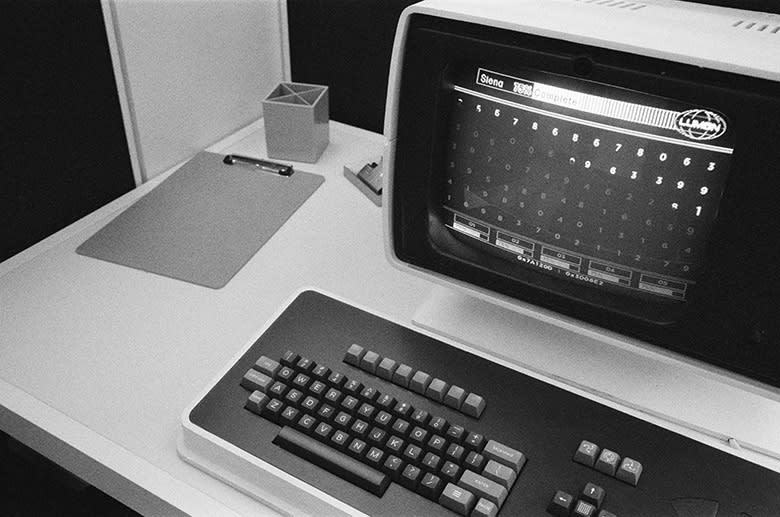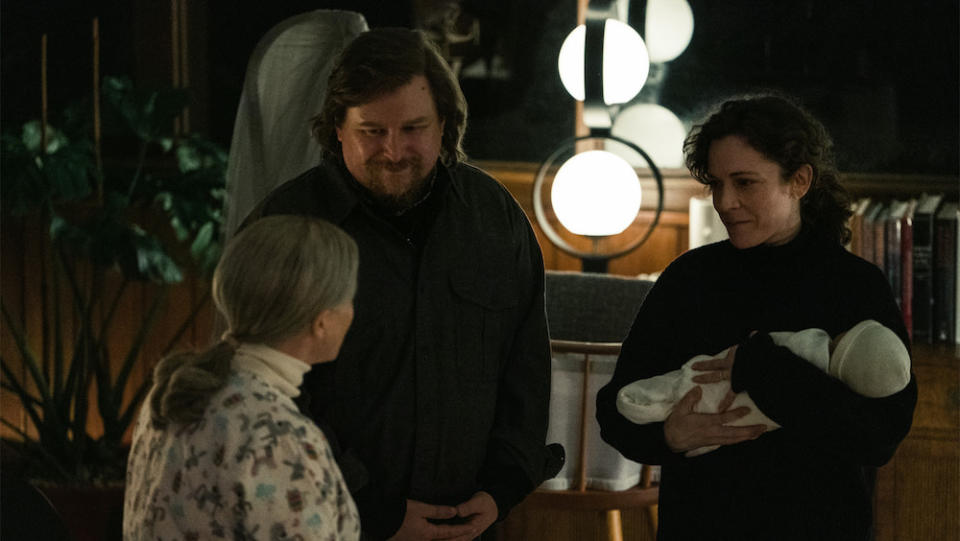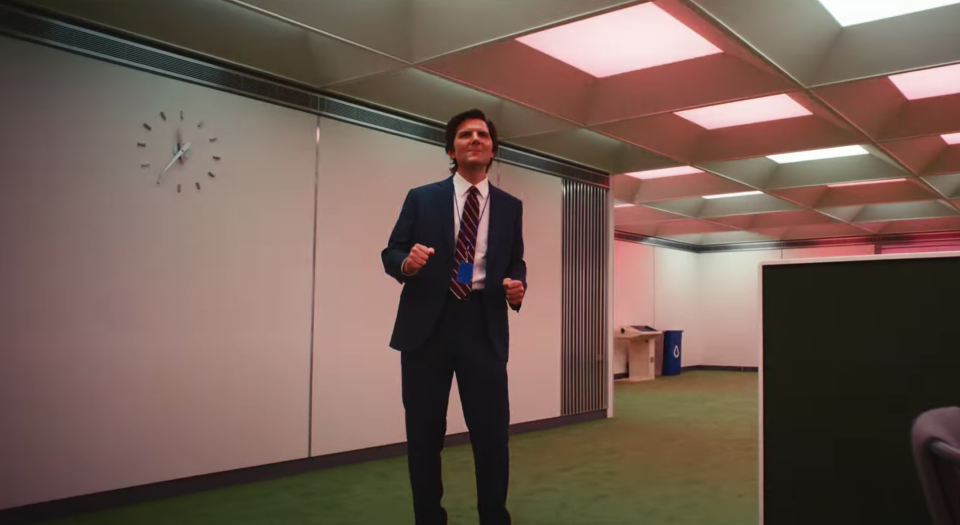‘Severance’ Designers Explain the Hidden Details of the Innie and Outie Worlds

Many sci-fi series require building a world from scratch, but “Severance” had more than one. The show, created by Dan Erickson and guided to fruition by director Ben Stiller, revolves around office workers who undergo a surgical procedure that allows them to separate their personal and professional lives. During the day, Mark (Adam Scott) and his co-workers undergo a bland, cryptic grind at the mysterious Lumon Industries, while their outside selves (otherwise known as “outies,” as opposed to “innies”) endure more familiar routines after hours. This dichotomy demanded precise visual signifiers to situate viewers in the dueling settings.
For production designer Jeremy Hindle, it presented the unique challenge of building out environments even if they didn’t always show every detail.
More from IndieWire
Craft Emmy Analysis: How Sci-Fi Genre Benders 'Severance' and 'Outer Range' Complicate the Races
'Severance' Creator Knew He Had a Hit the First Time He Saw the Memes
“The show is taking advantage of the unique way you can design a space,” Hindle told IndieWire. “The camera only has to reveal bits and pieces of it at a time. You don’t need the whole spatial orientation at first to get a sense of where things are in a room. There’s so many surprises.”
Hindle and set decorator Andrew Baseman spoke to IndieWire about how they transformed Erickson and Stiller’s vision for the show into a complex universe that has only started to take shape ahead of the second season.
‘Just an Office’
Lumon is an eerie place filled with long hallways, narrow corridors, and empty conference rooms. It required a design approach that was dull on the surface while hinting at stranger forces at work. “Visually, it’s like a spaceship, but it’s also just an office,” Hindle said, adding that was inspired in part by Jacques Tati’s slapstick classic “Playtime.”
The set was built on three New York sound stages in order to control every facet of the innies’ world, but the exteriors were a real place: The old headquarters of Bell Laboratories designed by Eero Saarinen in Holmdel, New Jersey had been restored in recent years and is now a mall. “It all the ceilings, the textures, and the scale we wanted for Lumon,” Hindle said. “That was the aesthetic we wanted — everything was so simple and perfect.” The season finale, which finds Helly (Britt Lower) roaming an event hosted by Lumon, was also shot in a ballroom of the old Bell Labs. “People are going to visit that building because of this show,” Hindle said. “The place is just massive.”

Apple TV+
Hallways of Mystery
Much of the action in “Severance” takes place throughout that extraordinary set, with hallways that often seem to stretch on for an eternity. “When someone walks down a hallway, that itself is suspense, because we don’t know where the hallway’s going to go,” Hindle said. “There’s just hundreds and hundreds of feet of hallways.”
The entire stage was 130 feet long, with the “Macrodata Refinement Department” where the main characters work at the center and the main hallway on the outside. “It looks like a rat maze,” Hindle said. “It’s really funny. The main thing is when they come out of the little tiny elevator into the lobby, the first hallways are narrower.” The ceiling was lowered several times over. “We did ceiling tests to see how well we could really bring it down to maximize its claustrophobic aspect, but also make it comfortable at the same time,” Hindle said.
The blinding whiteness of the walls created a unique challenge. “I think I tested about 30 whites for the camera test,” Hindle said. “We also tested six different kinds of green for the carpet. The green carpet is the most obnoxious color you’ve ever seen. It’s the one who wouldn’t affect your eye. It’s almost like a putting green, really horrific, but it worked with the grading.”
Supplies and Stuff

Apple TV+
As eagle-eyed “Severance” viewers have already pointed out, the MDR workers use computers with keyboards missing an escape key. That was far from the only metaphorical detail injected into the main office space to heighten the sense of control over the inhabitants’ lives. “We decided for the office environment that we should go back to before the ’80s, when human resources took over the offices and let you bring in plants and your kids’ photographs and all your bullshit mementos,” Hindle said. For Baseman, arranging the minimalist desks was a way to signal that something was a little off. “In our normal day to day life, our desktops typically aren’t immaculate like that,” he said.
The computers themselves were built from scratch with cathode-ray tube controller screens behind glass. Each one was fully usable — and got used. “If you’re watching John Turturro on his keyboard, watch what he does,” Hindle said. “It’s programmable and it’s moveable, so they’re all doing stuff while sitting there.”
For Baseman, a veteran set decorator whose credits range from “Mindhunter” to “Crazy Rich Asians,” the MDR space was especially appealing because it had a supply closet. “That small room is one of my favorite sets because it is so ordered within an inch of its life,” he said. “It’s not just the reams of paper. Beneath that are all the cleaning products. There’s four rows of staplers all lined up, and then on the shelves above, which are a little out of sight, I had fun with having years worth of lamps that were retired. There are lamps from the ’50s, ’60s, and ’70s. Things are very ordered, symmetrical, and just a bit off-putting.”
Men Who Stare at Goats
One of the biggest mysteries of “Severance” has yet to be resolved: What’s up with the goats?
When Mark and Helly wander Lumon at one point, they come across a strange room filled with baby goats and a man feeding them. “In Season 2, I think we’ll learn more about the goats,” said Baseman, who hinted that Erickson had provided the crew with some extra details not yet revealed on the show. It was enough for the set decorator to lean into the Easter egg potential of the device. “I’ve sprinkled goat items throughout the first season,” he said. The streets of Kier have goat imagery visible in shopfront windows, and in a clothing store, there’s a tie with a goat on it; for later episodes set at the home of self-help author Ricken Hale (Michael Chernus), there’s a statue of big-horned goat. “I just threw some things out like that, just to confuse people,” Baseman said with a grin.
The team kept the location of the goat room open-ended. “When I first asked Dan, ‘How far underground does this world go?'” he said, ‘Oh, miles,'” Hindle said. “There’s a whole world down there, which we all hopefully get to see next season.”
Mark’s Sad Basement
In the aftermath of a tragedy that destroyed his family life, Mark lives a rather drab routine as an outie. That’s reflected in his underwhelming bachelor pad . “Mark’s house was like corporate housing,” Hindle said. Baseman added that it was “all sparse, minimal, and mid-century — one sad sofa and a fish tank.”
But more of the character’s history seeps into the narrative when we see his box-filled basement, where tidbits of his origins are strewn about — a backstory that becomes more prominent as the season goes on. “We wanted to show that his former happy life with his wife was still down there,” Baseman said. “You see peeks of that in all the boxes and furniture. It’s much nicer than the stuff he has upstairs, but he just doesn’t want to be reminded of it.” Most boxes have labels informed by Mark’s history. “We thought of hobbies they had, things they enjoyed doing together,” Baseman said. “Camping, some happy Christmas memories represented by boxes of ornaments, family heirlooms, their former life together in academia, artwork.”
Fun With Frank Lloyd Wright

Atsushi Nishijima / Apple TV+
The final arc of the first season takes place during a tense party hosted by Ricken, whose work somehow informs the lives of the workers at Lumon. In his outie life, Mark lives in Ricken’s shadow: He’s married to Mark’s sister and often boasts of his professional success. That mentality is reflected by his surroundings on the show. “Ricken is so pretentious,” Hindle said. “So of course he would live in a Frank Lloyd Wright house.”
Wright, the famed architect who died in 1959, designed 47 homes in Pleasantville, New York that feature his trademark angular forms and striking glass windows. Hindle said his team scouted most of them. “The one I really loved was owned by a 96-year old man who had it commissioned when he was 26,” he said. “And he worked at Bell Labs, which is even weirder. Everything seems to be connected.”
While the house was already furnished, the team decided to select their own furniture to reflect Ricken’s selectivity. “It was the opposite of Mark’s world,” Baseman said. “We wanted this to be warm. So the colors are oranges. The whole palette is just showing that the outie world is a much friendlier, warmer place.”
The large home ended up so jam-packed with details about Ricken that the camera couldn’t capture it all. “That’s a tricky thing with showing any kind of minimalism,” Baseman said. “A few pieces have to be perfect because that’s all you’re seeing.” Still, look close enough and Ricken’s lifestyle comes into focus, in particular the way he surrounds himself with prizes of dubious value. “We have some literary awards on the wall that he’s very proud of,” Hindle said. “We also have a little archery award, where he came in third place as a participant in archery. So I have a little teeny archery award with some arrows. He also tried his hand at bonsai. That’s his latest hobby — he bought a brand new set of bonsai tools. Those are on his desk.”
The Dylan We Don’t See
All of Mark’s Lumon co-workers begin to question their commitment to the routine over the course of the first season, but none faces a more abrupt wakeup call than Dylan (Zach Cherry), the fun-loving waffle hound in his early innie scenes who abruptly learns he actually has a whole family when he’s abruptly woken up at night as his innie. In that scene, Dylan wakes up in a closet and only briefly manages to peer outside of it. But as usual, the “Severance” craft team felt they had to go much further than that. “We designed an entire first floor of his house,” Basemen said. “Dan was very specific. He wrote pages and pages of Dylan’s backstory. I loved how detailed it was.”
Dylan’s bedroom alone was jam-packed with information about his personal life that may or may not come up in future seasons. “You briefly see a framed puzzle of a landscape above his TV,” Baseman said. “That was a great image for him. Sadly, you don’t see any of it.” The dresser also featured photos of Dylan’s kids, a detail that comes up later in the scene. “In the living room I had a lot of kids’ things out,” Baseman said. “It was very messy, the opposite of the innie world of order.”
A Kier House in the Bronx
On several occasions, the Lumon employees visit the Kier House, a gothic structure oddly situated indoors within the bowels of Lumon Industries. Toward the end of the season, Dylan even receives a solitary waffle party there, before he’s treated to a bizarre dance number by masked performers. In truth, the Kier House was actually nowhere near the rest of the set. The exteriors were actually shot at the Glenview Historic Home, a mansion built in 1877 located in Yonkers that has also been featured on HBO’s “The Gilded Age.”
For “Severance,” the visual-effects crew used CGI to position the house inside the larger Lumon building. “To me, that is a great example of CG,” Hindle said. “I like to use CG to enhance something. You think this house has had 100 years to get to be the way it is. You can’t design that idea in two weeks or even six weeks.”
Baseman said the Victorian era of the house helped inform its exteriors. “The only artwork on the wall was Victorian hair weavings,” he said. “That was a thing in Victorian times used for a mourning, where you take a lock of someone’s hair and then weave little things out of it. It was just a macabre touch and better than beautiful oil paintings.” The walls were also lined with creepy remnants of the past. “There were three vials of some kind of medicinal herb,” he said. “That was all part of the history of Lumon. It was a whole array of stuff, like a museum of oddities and medical things.”
A Special Dance Cart

screenshot
One of the most talked-about scenes arrives in episode 8, when floor manager Milchick (Tramell Tillman) shows up to tell the MDR workers that they’ve been awarded a “music dance experience.” Milchick rolls in with a cart containing records and offers a series of musical genres to choose from. The lighting shifts from a bland halogen glow to neon red as Milchick embarks on a peculiar dance around the room. “Ben kept saying there was going to be a dance thing in one of the episodes and I was like, ‘An actual dance? How’s that going to work?'” They realized that while the green carpets would be darkened by the lighting scheme, the rectangular ceiling lights already installed could be used to their advantage. “It’s literally a reverse dance floor,” Hindle said.
Baseman found several carts for different scenes of the show, and said that the metal one used in the dance sequence was ordered online from Eastern Europe. “It was a unique piece,” he said. When Milchick crashes into it at the climax of the scene, “that was a stunt double,” Baseman added. “I made sure that they didn’t destroy the one beautiful one.”
Best of IndieWire
The Best 30 LGBTQ Movies and TV Shows Streaming on Netflix Right Now
10 LGBTQ Film and TV Creators on the Rise, from Jerrod Carmichael to Isabel Sandoval
Sign up for Indiewire's Newsletter. For the latest news, follow us on Facebook, Twitter, and Instagram.

